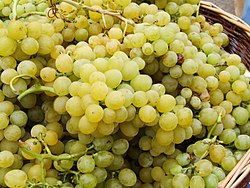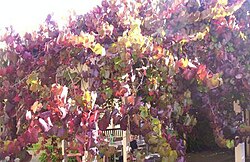AY Honors/Ultimate Disc/Answer Key
Template:Mergefrom Template:Taxobox Template:Wiktionarypar Template:For
A grape is the non-climacteric fruit that grows on the perennial and deciduous woody vines of the family Vitaceae. Grapes grow in clusters of 6 to 300, and can be black, blue, golden, green, purple, red, pink, brown, peach or white. They can be eaten raw or used for making jam, grape juice, jelly, wine and grape seed oil. Cultivation of grapevines occurs in vineyards, and is called viticulture. One who studies and practises growing grapes for wine is called a viticulturist.
Raisins are the dried fruit of the grapevine, and the name actually comes from the French word for "grape". Wild grapevines are often considered a nuisance weed, as they cover other plants with their usually rather aggressive growth.
The leaves of the grape vine itself are considered edible and are used in the production of dolmades.
Grapevines are used as food plants by the larvae of some Lepidoptera species - see list of Lepidoptera which feed on grapevines.
Grapevines
Many species of grapevines exist, including:
- Vitis vinifera, the European winemaking grapevine. Native to virtually all of mainland Europe.
- Vitis labrusca, the North American table and grape juice grapevines, sometimes used for wine. Native to the Eastern U.S. and Canada.
- Vitis riparia, a wild vine of North America, sometimes used for winemaking and for jam. Native to the entire Eastern U.S. and north to Quebec.
- [[Vitis
- Vitis vulpina Frost grape. Native to the Midwest east to the coast up through New York.
- Vitis cognitiae Ornamental Grape from East Asia, grown for its crimson autumn foliage.
There are many varieties of grapevines; most are cultivars of V. vinifera.
Species
Template:Col-start
Template:Col-break
Vitis acerifolia
Vitis aestivalis
Vitis amurensis
Vitis arizonica
Vitis x bourquina
Vitis californica
Template:Col-break
Vitis x champinii
Vitis cinerea
Vitis x doaniana
Vitis girdiana
Vitis labrusca
Vitis x labruscana
Template:Col-break
Vitis lincecumii
Vitis monticola
Vitis mustangensis
Vitis x novae-angliae
Vitis palmata
Vitis riparia
Template:Col-break
Vitis rotundifolia
Vitis rupestris
Vitis shuttleworthii
Vitis tiliifolia
Vitis vinifera
Vitis vulpina
Template:Col-end
Hybrid grapes also exist, and these are primarily crosses between V. vinifera and one or more varieties of V. labrusca, V. riparia or V. aestivalis. Hybrids tend to be less susceptible to frost and disease (notably phylloxera), but wine from some hybrids may have a little of the characteristic "foxy" odor of labrusca.
The sea grape Coccoloba uvifera is actually a member of the Buckwheat family Polygonaceae and is native to the lands of the Caribbean Sea.
Distribution
According to the "Food and Agriculture Organization" (FAO), 75,866 square kilometres of the world is dedicated to grapes. Approximately 71% of world grape production is used for wine, 27% as fresh fruit, and 2% as dried fruit. A portion of grape production goes to producing grape juice to be used as a sweetener for fruits canned "with no added sugar" and "100% natural". The area dedicated to vineyards is increasing by about 2% per year.
The following list of top wine-producers shows the corresponding areas dedicated to grapes for wine making:
- Spain 11,750 km²
- France 8,640 km²
- Italy 8,270 km²
- Turkey 8,120 km²
- United States 4,150 km²
- Iran 2,860 km²
- Romania 2,480 km²
- Portugal 2,160 km²
- Argentina 2,080 km²
- Australia 1,642 km²
Sources: FAO, Organisation Internationale de la Vigne et du Vin (pdf), Australian Wine and Brandy Corporation.
Comparing diets among western countries, researchers have discovered that although the French tend to eat higher levels of animal fat, surprisingly the incidence of heart disease remains low in France.[1] This phenomenon has been named the French Paradox. Many scientists now believe the reason is the greater consumption of red wine in France. Something in the grape helps to lower cholesterol levels in the body and thus slows the build up of deposits in the arteries. Compounds such as resveratrol (a polyphenol antioxidant) have been discovered in grapes and these have been positively linked to fighting cancer, heart disease, degenerative nerve disease and other ailments. Doctors do not recommend excessive consumption of red wine, but three or four glasses a week is beneficial and encouraged.
Red or not, grapes of all colors offer comparable benefits. Red wine offers health benefits not found in white wine, because many of the beneficial compounds are found in the skins of the grapes, and only red wine is fermented with the skins.
White grapes
White grapes are evolutionarily derived from the red grape. Mutations in two regulatory genes turn off production of anthocyanin, which is responsible for the colour of the red grape.&.
Raisins, currants, and sultanas
A raisin is any dried grape. A currant is a dried Zante grape, the name being a corruption of the French raisin de Corinthe (Corinth grape). A sultana was originally a raisin made from a specific type of grape of Turkish origin, but the word is now applied to raisins made from common North American grapes and chemically treated to resemble the traditional sultana.
Note that, while raisin is a French loanword, the word in French refers to the fresh fruit; grappe (whence the English grape is derived) refers to the bunch (as in une grappe de raisin). As raisin is uncountable in French, a single grape is a grain de raisin.
Note also that currant has come to refer also to the blackcurrant and redcurrant, two berries completely unrelated to grapes.
Seedlessness
Seedlessness is a highly desirable trait in table grape selection, and seedless cultivars now make up the overwhelming majority of table grape plantings. Because grapevines are vegetatively propagated by cuttings, the lack of seeds does not present a problem for reproduction. It is, however, an issue for breeders, who must either use a seeded variety as the female parent or rescue embryos early in development using tissue culture techniques. There are several sources of the seedlessness trait, and essentially all commercial cultivars get it from one of three sources: Thompson Seedless, Russian Seedless, and Black Monukka. All are members of Vitis vinifera.
Resveratrol
Template:Main Resveratrol is produced by several plants, apparently for its antifungal properties. It is found in widely varying amounts in grapes, primarily the skins and seeds. This is particularly true for muscadine grapes, whose skin and seeds have about one hundred times the concentration as the pulp.[2] The amount found in grape skins also varies with the grape cultivar, its geographic origin, and exposure to fungal infection. The amount of fermentation time a wine spends in contact with grape skins is an important determinant of its resveratrol content.[3]
Fresh grape skin contains about 50 to 100 micrograms of resveratrol per gram.[4] Ordinary non-muscadine red wine contains between 0.2 and 5.8 mg/L &, depending on the grape variety, while white wine has much less - the reason being that red wine is fermented with the skins, allowing the wine to absorb the resveratrol, whereas white wine is fermented after the skin has been removed. Wines produced from muscadine grapes, however, both red and white, may contain more than 40 mg/L.&. [5]
Diseases
References
- ↑ Template:Cite journal
- ↑ Gu X, Creasy L, Kester A, et al., Capillary electrophoretic determination of resveratrol in wines. J Agric Food Chem 47:3323-3277, 1999
- ↑ Ector BJ, Magee JB, Hegwood CP, Coign MJ. Resveratrol Concentration in Muscadine Berries, Juice, Pomace, Purees, Seeds, and Wines. http://www.ajevonline.org/cgi/content/abstract/47/1/57
See also
External links
- Integrated Taxonomic Information System entry for Grape family
- Area under vine (pdf)
- Wild Grapes
- 300 Grape Varieties for Wine
- Wine Wiki
als:Weintraube ar:عنب an:Uga ca:Vinya da:Vinstok de:Weintraube es:Uva eo:Vinbero fa:انگور fr:Raisin ko:포도 hr:Grožđe hu:Szőlő io:Vito id:Anggur it:Vitis he:גפן (צמח) mg:Voaloboka nah:Xocomecatl nl:Druif ja:ブドウ nn:Drue pl:Winorośl pt:Uva qu:Huk wayuq ru:Виноград simple:Grape sl:Grozdje sr:Грожђе fi:Viinirypäle sv:Vinrankor th:องุ่น vi:Nho zh:葡萄



